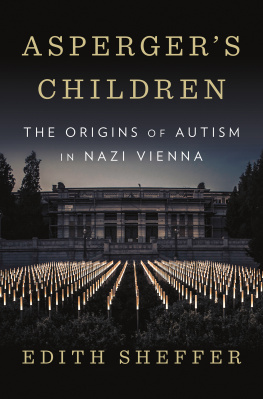
ASPERGERS
CHILDREN
Also by Edith Sheffer
Burned Bridge: How East and West Germans Made the Iron Curtain
ASPERGERS
CHILDREN
The Origins of Autism in Nazi Vienna
Edith Sheffer

Copyright 2018 by Edith Sheffer
All rights reserved
First Edition
For information about permission to reproduce selections from this book, write to
Permissions, W. W. Norton & Company, Inc., 500 Fifth Avenue, New York, NY 10110
For information about special discounts for bulk purchases, please contact
W. W. Norton Special Sales at specialsales@wwnorton.com or 800-233-4830
Book design by Ellen Cipriano
Production manager: Julia Druskin
JACKET DESIGN BY DARREN HAGGAR
JACKET PHOTOGRAPH ANDREAS DANZER
The Library of Congress has cataloged the printed edition as follows:
Names: Sheffer, Edith, author.
Title: Aspergers children : the origins of autism in Nazi Vienna / Edith Sheffer.
Description: First edition. | New York : W.W. Norton & Company, [2018] |
Includes bibliographical references and index.
Identifiers: LCCN 2018003422 | ISBN 9780393609646 (hardcover)
Subjects: LCSH: Aspergers syndrome in childrenPatients
AustriaViennaHistory. | Aspergers syndrome in children
DiagnosisAustriaVienna20th century. | Aspergers syndrome in
childrenAustriaViennaHistory19301940. | Asperger, Hans.
Classification: LCC RJ506.A9 S5257 2018 | DDC 618.92/85883200943613dc23
LC record available at https://lccn.loc.gov/2018003422
ISBN 978-0-393-60965-3 (e-book)
W. W. Norton & Company, Inc., 500 Fifth Avenue, New York, N.Y. 10110
www.wwnorton.com
W. W. Norton & Company Ltd., 15 Carlisle Street, London W1D 3BS
To my son,
Eric
CONTENTS
W hat is the difference between a butterfly and a fly? The butterfly does not grow up in the room as the fly does, said Harro. This was his intelligence test. Harro chose to talk about the fly:
It has a completely different development! The fly mother lays many, many eggs in a gap in the floorboards and then a few days later the maggots crawl out. I have read this once in a book, where the floor talksI could die laughing when I think of itwhat is looking out of this little tub? A giant head with a tiny body and a trunk like an elephant? And then a few days later they cocoon themselves in and then suddenly there are some dear little flies crawling out.
Harro and other children were growing up in a room, too, cocooned at Hans Aspergers Curative Education Clinic at the University of Vienna Childrens Hospital. Like the curiously shaped larvae, they stuck out. Differences such as theirs had become more objectionable in the Third Reich, and the doctors and nurses on the ward were working to develop the children. Asperger held that with proper understanding, love and
Asperger said he valued the unique characters of the children he treated, tailoring his approach to their individual needs. He had a holistic approach. Children at the elegant and open Widerhofer Pavilion engaged in a range of activities, from sports to drama to music. Asperger sat with the children, his tall frame hunched over to connect with them at their level. With his intent gaze, he noted all realms of their behavior in his postdoctoral thesis. Harro was one of the case studies for his new diagnosis: autistic psychopathy.
Harros school had referred the boy to Aspergers Curative Education Clinic for evaluation. Its report stated that the eight and a half year old seldom did as he was told. Harro talked back, did not do his homework, and complained his lessons were far too stupid. He was ridiculed by his classmates, and hit and injured other boys over petty issues. Harro was even said to crawl on all fours during lessons and commit homosexual acts. His teachers maintained that the boy could succeed if he wanted to. But Harro had failed every subject and was repeating a grade.
He was difficult to test, often uncooperative and unsuccessful in conventional tasks. In certain areas, Harro demonstrated skills beyond his age. With math, for example, he came to solutions in his own way. What is 47 minus 15? 32either add 3 and also add 3 to that which should be taken away, or first take away 7 and then 8. Asperger saw such exceptional originality as evidence of special abilities in many boys.
The problem, as Asperger saw it, was that Harro did not have social feeling. Asperger said Harro went his own way in a group, and never became warm, trusting or cheerful in the ward. Harro resisted the important social habits of daily life. He did not play with other children, but spent much of his time reading in a corner, indifferent. When teased, Asperger held that Harro lacked any sense of humor. He had a lost gaze and few facial expressions and gestures.
Asperger decided that Harro demonstrated autistic psychopathy. But because of his intelligence, Harro was on the favorable end of the autistic range. That meant he was capable of remediation and joining What these promising children needed, Asperger wrote, was individualized care to nurture their cognitive and emotional growth. He sympathized with their challenges, advocated their potential, and celebrated their uniqueness.
This is the benevolent image of Asperger today. But it represents only one side of Aspergers work. While Asperger did support children he believed to be teachable, defending their disabilities, he was dismissive about those he believed to be more disabled. Deprecatory pronouncements could be a death sentence in the Third Reich. And in fact, some of Aspergers judgments were death sentences.
Although Harro passed Aspergers test, Aspergers label of autistic psychopathy still underestimated the boy. Asperger contended that autistic children did not really fit into this world and looked as if they had just fallen from the skybut Harro had not really fallen. Like the fly, he was simply making his own way. Harro explained, The fly is much more skillful and can walk up the slippery glass and can walk up the wall... just yesterday I saw it has teeny weeny claws on the feet and at the ends tiny little hooks; when it feels that it slips, then it hooks itself up with the hooks.
This is not a story about one boy, however. Nor is it about children on the luckier end of Aspergers autistic range. This book is about all the children who faced the Third Reichs diagnosis regime, and how Nazi psychiatry judged their minds and determined their fates. Diagnoses reflect a societys values, concerns, and hopes. As this book uncovers the nightmarish contexts of autisms creation, it reveals how what today appears to be a singular idea rested upon the community that made it. Aspergers diagnosis of autistic psychopathy emerged from the values and institutions of the Third Reich.
T HE TERM AUTISM was introduced in 1911 by Eugen Bleuler, a Swiss psychiatrist who used it to describe schizophrenic patients who appeared disconnected from the outside world. Hans Asperger and
Kanner, by then based at Johns Hopkins in the United States (where he would be regarded as the father of American child psychiatry) published his work on autism, Autistic Disturbances of Affective Contact, in 1943. The same year, in Vienna, Asperger presented his postdoctoral thesis, The Autistic Psychopaths in Childhood, which he published in 1944. Kanner described children he considered to be relatively similar to one another. He saw them as socially and emotionally withdrawn, and preoccupied with objects and ritualswith repetitive behavior, little to no speech, and severe cognitive impairments. This is now called classic, or Kanner-type autism. For decades, practitioners in the United States went by this narrower definition. Autism was a relatively rare diagnosis: 1 in 5,000 in 1975.
Next page









